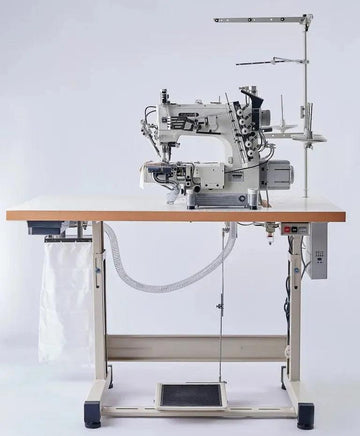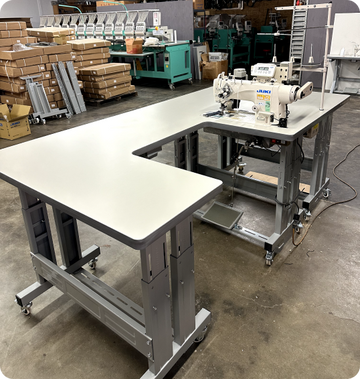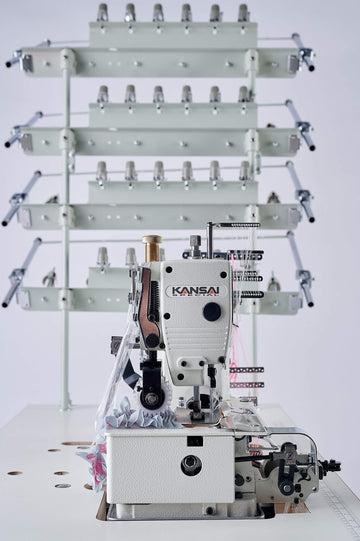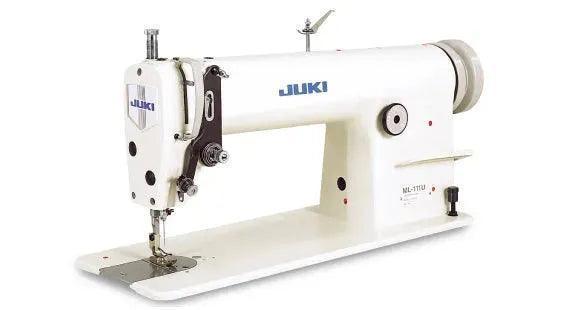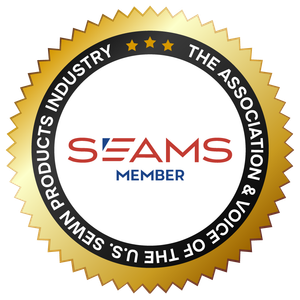Basting Machines
Baste sewing machines create loose stitches to hold layers of fabric together until the final stitch. They prevent fabrics from moving until a basting stitch is taken out. A basting stitch creates a temporary hem, helping you adjust the length and ensure the visual accuracy. This is why this type of machine happens to be common in industrial and professional sewing applications.
40+ Years of Trust
Empowering top manufacturers since 1981
KANSAI Distributor
Best specialized machines & support
Lifetime Warranty
On all PRIZZI custom sewing tables
100% New Machines
Come with the standard manufacturer's warranties
End-of-the-Year Sale
Up to 50% OFF Sitewide + Promocode
days
days
hours
hrs
minutes
mins
seconds
secs
Basting Machine ML-111U
2. What Is a Basting Sewing Machine?
A basting sewing machine is a type of sewing equipment that creates long, temporary stitches that keep fabric layers together before making the final stitch. They are used for making the necessary adjustments without making permanent seams. Unlike regular sewing techniques, basting stitches are longer and looser, usually 4mm or more in length. These stitches are easy to remove by hand and do not lock the thread at the ends. Basting machines are perfect for tailoring and quilting purposes, enabling high accuracy.
Read more2. What Is a Basting Sewing Machine?
A basting sewing machine is a type of sewing equipment that creates long, temporary stitches that keep fabric layers together before making the final stitch. They are used for making the necessary adjustments without making permanent seams. Unlike regular sewing techniques, basting stitches are longer and looser, usually 4mm or more in length. These stitches are easy to remove by hand and do not lock the thread at the ends. Basting machines are perfect for tailoring and quilting purposes, enabling high accuracy.
3. Types of Basting Stitches in Sewing Machines
Be aware of different machine basting stitches, each used for specific tasks. Machine basting stitches use the longest stitch length (typically 4–6 mm) on a sewing machine. They keep layers of fabrics together in garment construction and quilting. Hand basting stitches include even basting (uniform stitch length), uneven basting (combination of short and long stitches), and slip basting (can’t be seen from the fabric's right side) methods. They provide more control when working with delicate or curved materials. Machine basting takes less time, butit can’t hold delicate fabrics properly. Hand basting gives more precision, especially when it comes to complex curves or heavy layers.
4. Features of Industrial Basting Sewing Machines
Basting is a longer hand or machine stitch that serves as a stabilizer to hold layers of fabric together in the industrial sewing process. The average industrial basting sewing machine comes with these features:
Stitch length adjustment. Longer stitch lengths (4–6 mm or more) enabling easy removal after final stitching;
Needle and thread compatibility. Different sizes of needles and types of threads to be used for various fabrics;
Speed, automation, and efficiency. Quick stitching techniques enabling productivity through automation;
Control options (manual, computerized). Manual and computerized models offering control over production needs.
These machines serve simplicity and functionality. Essential stitches are perfect for simple and more complex sewing tasks.
5. Common Uses and Applications
The use of the basting stitch sewing machine has become a common thing in many industries. Here are the main use cases to consider:
Garment manufacturing. Holding pieces of fabric together before final stitching, ensuring the accuracy of the final product;
Quilting and tailoring. Securing multiple layers of fabric, batting to prevent any movement, as well as fitting and shaping the garment;
Temporary seams for fitting and testing. Checking the garment and making the necessary modifications without damaging the fabric.
6. How to Choose a Basting Stitch Machine
Choosing the right sewing basting machine for industrial and commercial purposes takes effort. These tips may help you make the right decision:
-
Consider your fabric type, production volume, and budget.
-
Check the machine’s use terms, stitch quality, and maintenance needs.
-
Ensure the machine’s compatibility with industrial settings.
-
Check other features you want to see in the sewing machine.
-
Ensure you have enough space to place a sewing machine on a table or any other surface.
Don’t rush to a decision. Choose the correct sewing machine for your needs. Learn about features and functions beforehand.
7. Maintenance and Care
You can’t fully prevent thread breakage or tangling of the basting stitch machine. But you can reduce the possible issues through proper maintenance.
Regular cleaning and oiling. Remove lint, dust, and fabric debris from the bobbin area, feed dogs, and thread path. Oil moving parts to reduce wear.
Troubleshooting common issues. Check for skipped stitches or thread bunching. Replace bent or dull needles. Re-thread the machine properly. Adjust upper and lower thread tension as needed.
Ensuring consistent performance. Inspect and adjust stitch length settings each time you use the machine. Use a compatible needle and thread for your type of fabric. Schedule professional maintenance on a regular basis.
The manufacturer may provide some additional guidance in the blueprint. With the right action, you can get your basting sewing machine working for years. Don’t forget to follow the instructions above.
8. Conclusion
Looking for a basting stitches sewing machine in South El Monte, Los Angeles, California? You will be surprised to see a great variety of options from the best brands. Compare the available models based on their price, quality, and functionality. Make sure the manufacturer offers a warranty as protection from early damage or malfunction. Finding the right balance between cost and quality would be good for you and your industrial needs. Don’t rush with the decisions. Check things twice before making a purchase!
Read lessFAQ
What is a basting stitch on a sewing machine?
A basting stitch is a long, temporary stitch used to hold layers of fabric together before permanent stitching. It helps in checking fit, alignment, or placement without committing to a final seam. On a sewing machine, it’s typically done using the longest possible stitch length, with loose tension so it’s easy to remove later.
How do you do a basting stitch on a sewing machine?
To make a basting stitch, set your sewing machine to its longest stitch length (usually around 4–5 mm or higher). Sew as you normally would, but don’t backstitch at the beginning or end—this keeps the thread easy to pull out later. You can baste along seam lines, hems, or areas you want to test-fit before final stitching.
What is a good stitch length for basting on an embroidery machine?
On an embroidery machine, a good stitch length for basting is typically between 4.0 mm and 6.0 mm. This provides a long, loose stitch that’s easy to remove after the embroidery is finished. Many embroidery machines also have a built-in “basting box” function that automatically places long stitches around your design to hold fabric and stabilizer in place.
Why does my machine basting stitch stick when gathering?
If your basting stitch sticks when gathering, it’s usually because the stitch tension is too tight or the stitch length is too short. Try loosening the upper thread tension and increasing the stitch length to 5 mm or more. Also, make sure you’re using smooth thread and not backstitching, as that can prevent the threads from pulling easily for gathering.
What happens if I machine stitch over a basting stitch?
If you sew over a basting stitch, the temporary thread may become trapped under the permanent seam, making it difficult or impossible to remove cleanly. To avoid this, remove the basting stitches before sewing your final seam, or baste just outside the seam allowance so you can pull it out easily afterward.
How do I set a basting stitch on a sewing machine?
To set a basting stitch, turn your machine’s stitch length dial or touchscreen to the longest setting—usually labeled 4, 5, or “long stitch.” Reduce the top thread tension slightly if needed for easier removal. Then, sew as normal without backstitching. You’ve now set your machine to make temporary, easy-to-remove basting stitches.
- Featured
- Best selling
- Alphabetically, A-Z
- Alphabetically, Z-A
- Price, low to high
- Price, high to low
- Date, old to new
- Date, new to old
